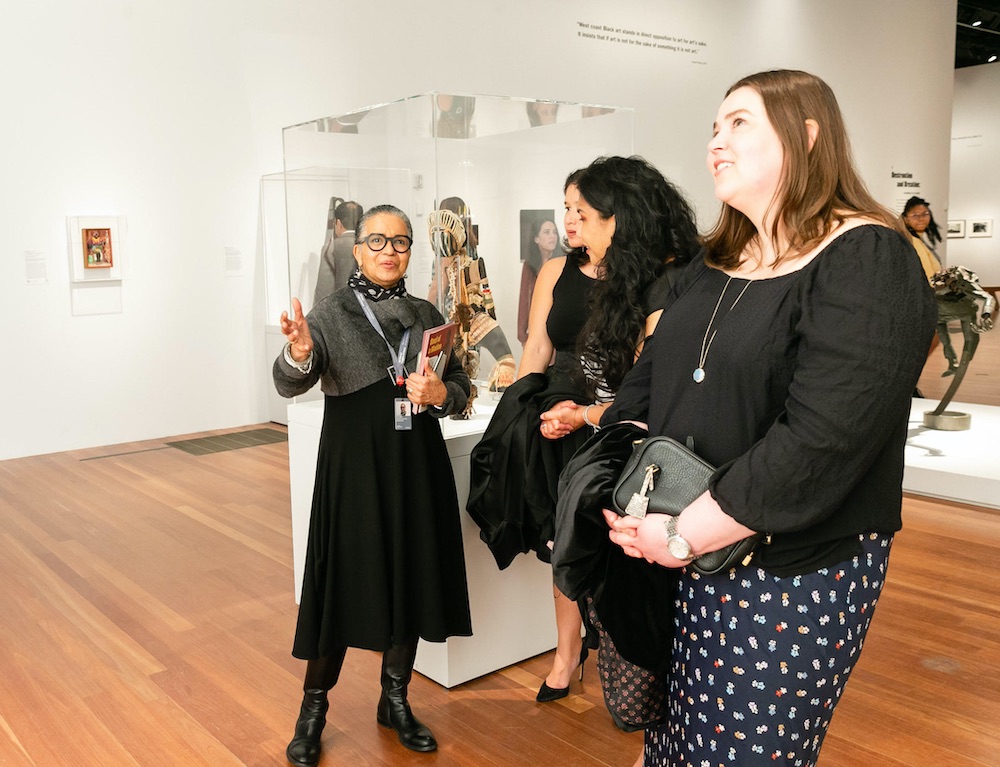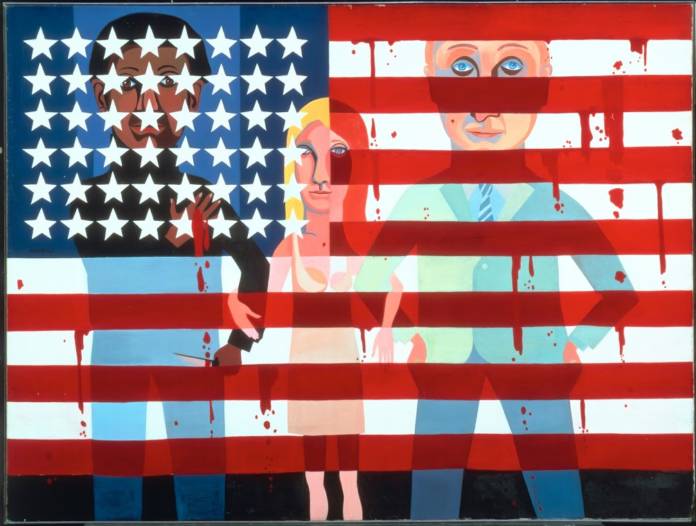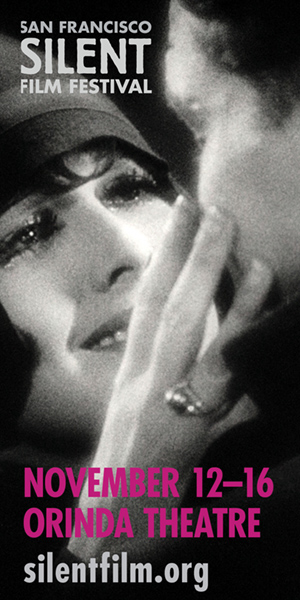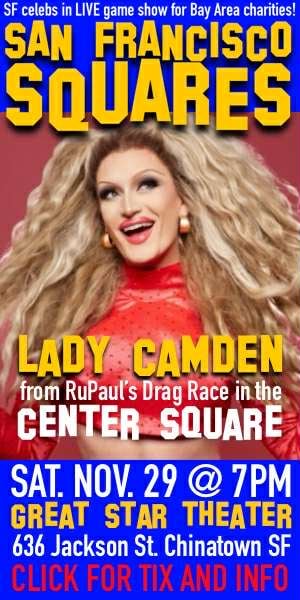The Fine Arts Museums of San Francisco started its Community Representatives program back in 1992 when it hosted an exhibit of the work of Henry Ossawa Tanner. But it was with the Revelations: Art from the African American South exhibit that “codified” the program, according to FAMSF’S director of education, Sheila Pressley.
Pressley says that, like at many museums, the staff and the docents at the FAMSF are predominantly white, and they want people who represent the diversity of the Bay Area. The de Young’s Soul of a Nation exhibit (through Sat/15) has Community Representatives—20 college students who are paid for their work and eight volunteers. The upcoming Frieda Kahlo exhibit which opens March 21 will also have them. After that exhibit closes in July, the museum hopes to bring the representatives to work with the permanent collection as well.
(Read more about the Soul of a Nation exhibit here. On Sat/15 at 2pm the exhibit hosts a talk with Bay Area musician and filmmaker Boots Riley.)
“We’re a city museum and now we’re free on Saturday for Bay Area residents,” Pressley said. “The connection the representatives make is really, really helpful for new audiences who may not feel comfortable in museums. It’s so important to provide an array of representatives and different voices.”
The students who are working for Soul of a Nation come from local schools like Stanford University, University of California, Berkeley, the San Francisco Art Institute, and San Francisco State University. Pressley recently read over the applications from students to work for the Frieda Kahlo exhibit, and these are some of the things they said:
“As a child of two immigrant parents from Mexico, the opportunity to share my culture in a reflective manner is important especially considering today’s anti-immigrant rhetoric.”
“Previously, museums have been intimidating for me to approach. . . It would be an honor to encourage interaction and conversations with visitors like me.”
“Community work has always been a focus of mine— inviting and interacting with marginalized communities who usually do not feel invited or represented in higher art institutions to aid in breaking the stigma that galleries are gated spaces.”
Help us save local journalism!
Every tax-deductible donation helps us grow to cover the issues that mean the most to our community. Become a 48 Hills Hero and support the only daily progressive news source in the Bay Area.
Before they start, the representatives do a few sessions of training and some readings. The main idea, Pressley says, is for them to facilitate open ended questions, encourage visual thinking, let visitors have own reactions to the art and to draw out the visitors’ perspectives. Pressley hopes everyone coming to the museum will feel welcome and know that they don’t need any specialized knowledge to look at art.
Some current Community Representatives—a student and volunteers—answered to a few questions about their experiences with the Soul of a Nation show by email.

BLAIR THOMAS
Why did you want to be a Community Representative at the Fine Arts Museums for Soul of a Nation?
I wanted to be part of something bigger than myself. To be able to speak about the artists who opened the doors for Black artists today is my dream.
What are you studying in school?
I am a double major in Art and Psychology, and I hope to become an art therapist in the near future.
When did you first get interested in art?
As long as I can remember, I read everything I could get my hands on. That soon led to me drawing all the things I read about and observed.
What do you like most about being a Community Representative?
I love seeing the excitement in people’s eyes. Talking about how it makes them feel and allowing the visitors to gain a deeper understanding of the work is amazing.
What’s your favorite section or piece in Soul of a Nation?
My favorite piece is Gradual Troop Withdrawal by John T. Riddle. It is just so raw and open in a way that makes people connect with it. I love how it transcends the time of when it was created.
OLIVETTE SMITH
Why did you want to be a Community Representative at the Fine Arts Museums for Soul of a Nation?
Having had the opportunity of education and training was a ‘life changing experience’ with the Revelations exhibition. I thought SOAN was sure to broaden my intellect and deepen my passion and understanding the scope of artist talent, skill set and knowledge as well as the beauty of the collaboration among artists like Charles White and David Hammons.
When did you first get interested in art?
I’ve grown up with art exhibits, national shows, with limited African American artists. For me, exposure to African American Artists began during1963-83 with the Civil Rights movement. Honestly, my interest in history through art knows no boundaries now.
What do you like most about being a Community Representative?
I like adding support and depth to a historical narrative and to some of the richest contributions in history. The personal exchanges enrich me deeply. I like drawing parallels with history… then vs now.
What is your favorite section or piece in Soul of a Nation?
Charles White’s Wanted Poster No. 5 and Mississippi, David Hammons’ and Roy DeCarava’s work, and the work of Black women like Faith Ringgold, Betye Saar, and Jae Jarrell

CHERYL WARD
Why did you want to be a Community Representative for Soul of a Nation?
I wanted to further my knowledge of work of this period and share what I have learned. I am an avid supporter of artists and an art collector, and I have done two previous shows (Jacob Lawrence and Revelations). I love being in museums!
When did you first get interested in art?
As a teen, spending time with an artist uncle.
What do you like most about being a Community Representative?
I liked the training and educational preparation for the experience and the lectures, discussions, and assignments. I also like sharing knowledge with interested visitors and hearing stories from others. It’s fun to meeting other Com Reps and to support students, encourage others to visit the exhibition and lectures, and to spend time in the galleries, watching reactions to the work and overhearing comments.
What is your favorite section or piece in Soul of a Nation?
Section: The “Los Angeles Assemblage” gallery [artists responding to the Watts Rebellion]. I have met many of the artists.
Piece: So difficult to choose! Barkley Hendricks, Frank Bowling, AfriCOBRA, etc, etc!
JACQUELINE BOGGAN
Why did you want to be a Community Representative at the Fine Arts Museums for Soul of a Nation?
I was made aware of the opportunity to become a Community Representative by Belva Davis. She informed me that the de Young was seeking African Americans to discuss works of art in the Revelations exhibit several years ago.
As a person who has collected African American art and collectibles for more than 40 years, I was curious about this new opportunity. Being in a position to have dialogue with museum visitors to discuss African American artists, struck me as unusual and therefore I wanted to be a part of this! It also demonstrated that the de Young was actively seeking African American input, which was a surprise. When I was invited to be a Community Representative for SOAN, I was delighted!
When did you first get interested in art?
I first became interested in art as a young adult while living in Washington, DC. in 1967, which was during the Black Power movement.
What do you like most about being a Community Representative?
The opportunity to dialogue with people face to face about art by African Americans and to listen to their respective views. It is fascinating to hear these viewpoints from different ages and various ethnicities. I especially enjoyed the children because the look on their faces when asked their opinion was fun. Typically a museum visitor looks at the works of art in silence. And if they are on a docent tour, the docent does most of the talking.
What is your favorite section or piece in Soul of a Nation?
I do not have a favorite section or piece in SOAN. All of the art works speak volumes about the experience of African Americans from 1963-1983. Each artist’s work is unique and displays their different approaches to making art that reflects the time period. This is a talent that many museum-goers have never seen. And just to think—the number of artists in this exhibit are only the “tip of the iceberg” of the many accomplished African American artists.
In addition, I applaud the de Young for adding to this tremendous exhibit works by California artists with emphasis on Bay Area artists! Museum visitors have been enriched with African Americans artists being included in a major museum. It is my hope that now people will actively seek work of African American artists and if they find it absent from museums, request they include these Americans whose works deserve to be shown.
SOUL OF A NATION
Through March 15
De Young Museum, SF.
More info here.






